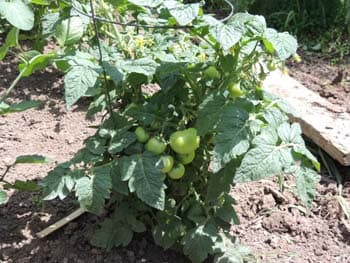Staking Tomato Plants - Tomato Cages

About Versatile Tomato Cages
Gardeners seek to maximize their harvest and produce the healthiest fruits. For tomato gardeners, staking tomato plants is an absolute necessity. Tomato cages are the most popular way to prop up plants and keep fruit off the ground. Caged plants stay healthier, too.
A very small number of gardeners grow tomato plants without providing some method of support. They lose both the quality and quantity of their harvest. Fruit that touches the ground, is easily accessible to ground insects and pests, most notably slugs. Tomatoes resting on the ground can rot. They are often damaged or ruined by contact with the soil.
Most gardeners use some kind of support for their tomato plants. There is a wide variety of supports to choose from. Staking tomatoes with tomato cages are by far the most common means of supporting the plants.
Did you know? Many indeterminate varieties of tomatoes grow six to eight feet in a season. The plants can’t reach their potential, without some form of support.
Garden Tip: It is also important to prune the plants. How to prune tomato plants
Ways to Support Tomato Plants
Staking Tomato Plants
Staking tomatoes is fairly simple. Use a stake that is six to ten feet long. Pound it firmly into the ground near the young plant. The stake should be deep enough in the ground to support a big plant, heavily laden with fruit. As the plants grow, use garden twine, or soft cloth strips to tie the main stem(s) loosely to the stake. Tie the stems to the stake every several inches. Tie them loosely, to avoid strangling the stems.
Tomato Veggie Rings are relatively new on the market and work great with wood or metal stakes.
Tip: Stake tomato plants very early in the season, to avoid damaging or disturbing the roots.

Caging Tomato Plants
A tomato cage is the simplest way to support your plants. Due to its simplicity, a cage is the most popular means of support, too.
There are two types of tomato cages- wire cages and a plastic “veggie cage”. Either type of cage is easy to use.
For wire tomato cages, just bend the legs outward a little, to spread them out. Then, stick the legs into the ground. It’s easy to train the main vines to grow inside the cage. The bigger the tomato plant, the bigger the wire cage. Tomato cages are from three to six feet tall. Many tomato varieties grow much larger. Keep this in mind when buying wire cages. For additional support, drive a stake into the ground through the cage. Without a garden stake, the weight of the plant and fruit can cause the wire cage to bend and fall over.
When using veggie cages, first drive a garden stake into the ground next to the plant. The veggie cage is easily raised, up to several feet tall, and fastened to the ground with a garden stake. Train the main stems to grow inside the veggie cage. More on Veggie Cages
Wire tomato cages can be stacked for winter storage. They still take up a fair amount of space. Plastic veggie cages fold down and take up almost no space in your shed.
Tomato Trellis
Trellises are constructed of a thicker, stronger (usually) metal material. They are more expensive. They last longer and are more attractive.
Fencing
Some people, especially gardeners in urban settings, grow tomatoes along a fence. As the plant grows, the main vines (branches) are tied up to the fence. It is effective and helps to best utilize limited space. Set up and tying plants can be a tedious process. The same applies to taking them down at the end of the season.
Related Articles
People who like this article will also like:
Learn all about growing Tomatoes:
Garden Recipes:
Please support our site. Shop for:
- rmmatthews100@hotmail.com
- 585-721-6528
- Rochester, NY
©1999-2024 GardenersNet.Com, All Rights Reserved

